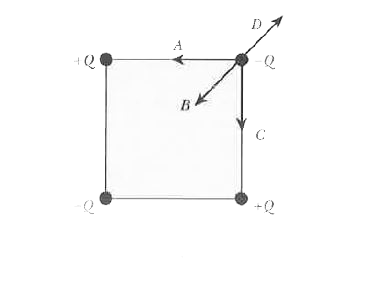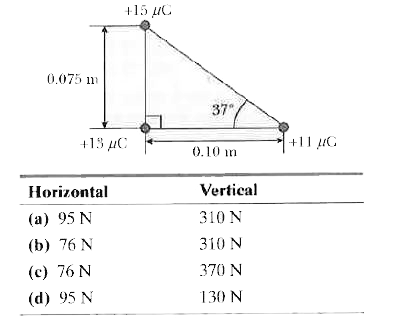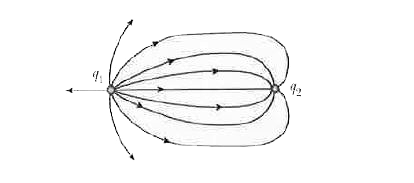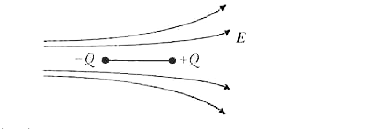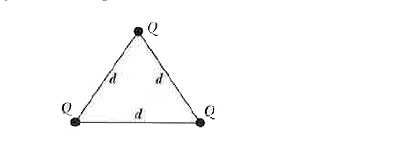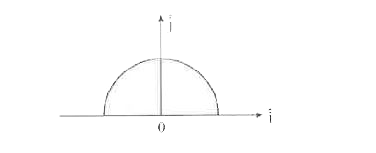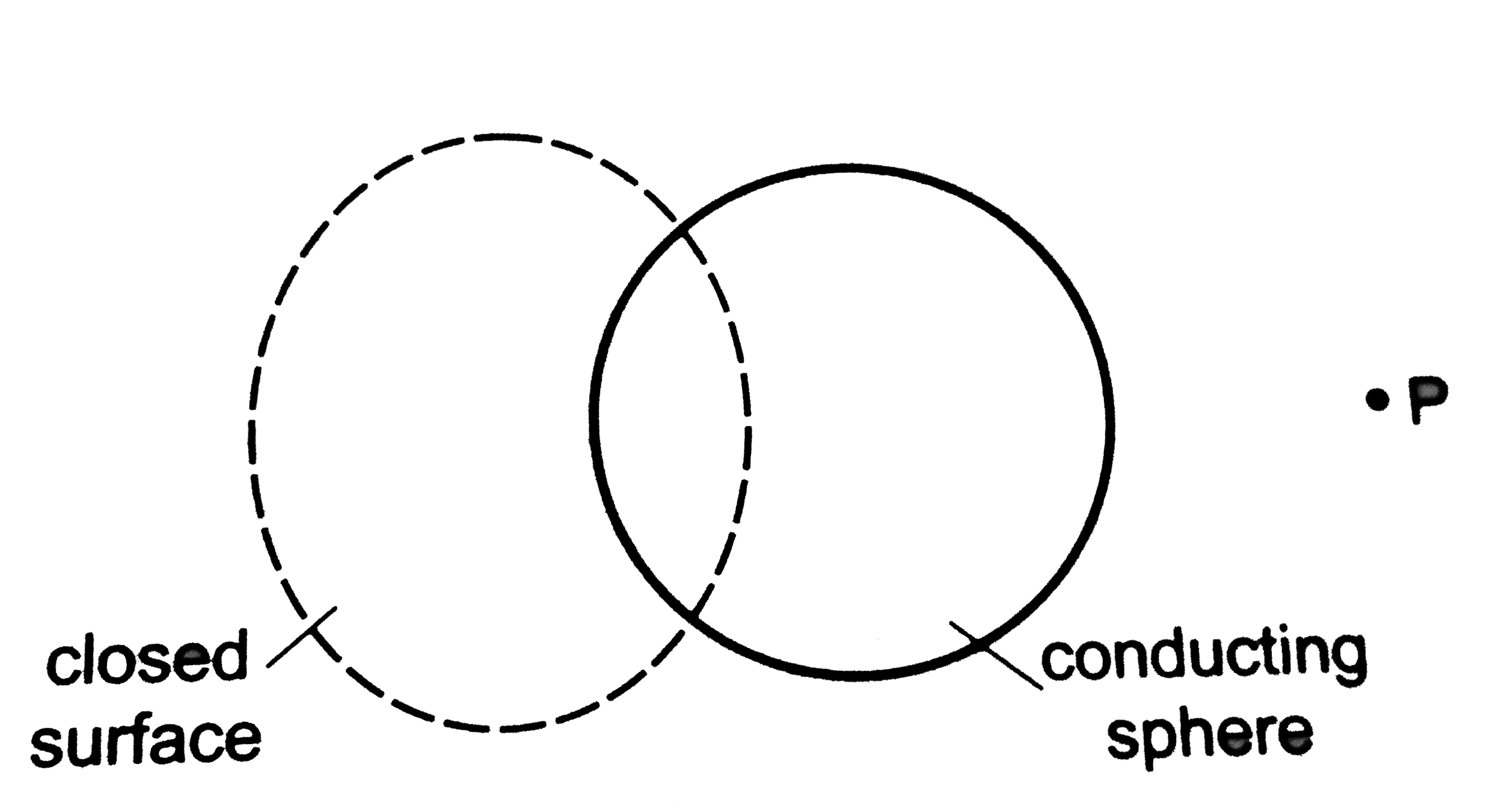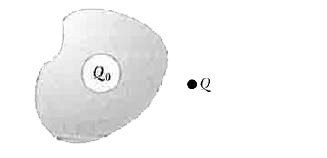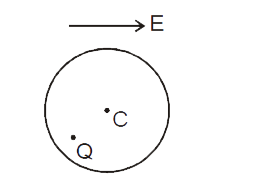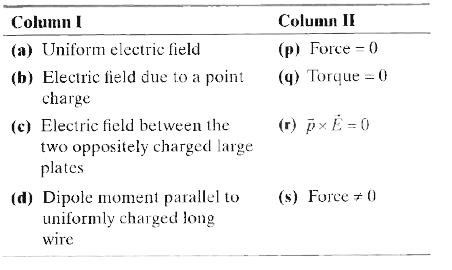Practice Questions (Linked Comprehension) from RESNICK AND HALLIDAY PHYSICS (HINGLISH) ELECTRIC CHARGES AND FIELDS for Class 12
| Class 12 | PHYSICS |
| Chapter | ELECTRIC CHARGES AND FIELDS |
| RESNICK AND HALLIDAY PHYSICS (HINGLISH) | Practice Questions (Linked Comprehension) |
| Medium | English |
| Academic Year | 2023-2024 |
Question 6
Two uncharged conducting spheres, A and B, are suspended from insulating threads so that they touch each other as shown in the figure. While a negatively charged rod is held near, but not touching sphere A, someone moves ball B away from A. How will the spheres be charged, if at all ?
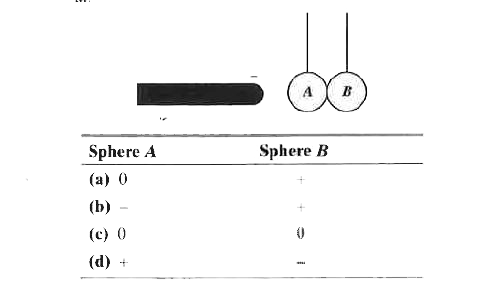 View Solution
View SolutionQuestion 8
Two point charges qA=3μC and qB=−3μC are located 20 cm apart in vaccum (a) what is the electric field at the mid point O of the line AB joining the two charges ? (b) If a negative test charge of magnitude 1.5×10−9C is placed at the point, what is the force experienced by the test charge ?View SolutionQuestion 10
Two tiny conducting spheres are identical any carry charges of −20.0μC and +50.0μC. They are separated by a distance of 2.50 cm. The spheres are brought into contact and then separated to a distance of 2.50 cm. Determine the magnitude of the force that each sphere now experiences, and state whether the force is attractive or repulsive.View SolutionQuestion 13
Consider three identical metal spheres, A, B and C. Sphere A carries of −2.0μC, spheres B carries a charge of −6.0μC, and spheres C carries a charge of +5.0μC. Sphere A and B are touched together and then separated. Sphere B and C are then touched and separated. Does sphere C end up with an excess or a deficiency of electrons and how many electrons is it ?View SolutionQuestion 14
An early model for an atom considered to have a positively charged point nucleus of charge Ze surrounded by a uniform density of negative charge up to a radius R. The atom as a whole is neutral. For this model, what is the electric field a distance r from the nucleus, where r>R ?View SolutionQuestion 15
Two identical charges +Q are kept fixed some distance apart.A small particles P with charge q is placed midway between them . If P is given a small displacement Δ ,it will undergo simple harmonic motion if
(i) q is positive and Δ is along the line joining the charges
(ii) q is positive and Δ is perpendicular to the line joining the charges
(iii) q is negative and Δ is perpendicular to the line joining the charges
(iv) q is positive and Δ is along the line joining the chargesView SolutionQuestion 23
Four point charges have equal magnitudes. Three are positive, and one is negative, as the drawing shows. They are fixed in place on the same straight line, and adjacent charges are equally separated by a distance d. Consider the net electrostatic force acting on each charge. Calculate the ratio of the largest to the smallest net force.
 View Solution
View SolutionQuestion 25
The membrane surrounding a living cell consists of an inner and an outer wall that are separated by a small space. Assume that the membrane acts like a parallel plate capacitor in which the effective charge density on the inner and outer walls has a magnitude of 7.1×10−6C/m2. What is the magnitude of the electric field within the cell membrane ?View SolutionQuestion 27
There are four charges, each with a magnitude of 2.0μC. Two are positive and two are negative. The charges are fixed to the corners of a 0.30 m square, one to a corner, in such a way that the net force on any charge is directed toward the center of the square. Find the magnitude of the net electrostatic force experienced by any charge.View SolutionQuestion 29
The following figure shows an equilateral triangle, each side of which has length of 2.00 cm. Point charges are fixed to each corner, as shown. The 4.0μC charge experiences a net force due to the charges qA and qB. This net force points vertically downward and has a magnitude of 405 N. Determine the magnitudes and algebraic signs of the charges qA and qB.
 View Solution
View SolutionQuestion 31
Two identical conducting spheres carry charges of +5.0μC and −10μC, respectively. The centers of the spheres are initially separated by a distance L. The two spheres are brought together so that they are in contact. The spheres are then returned to their original separation L. What is the ratio of the magnitude of the electric force on either sphere after the spheres are touched to that before they were touched ?View SolutionQuestion 32
A charge +q is located at the origin, while an identical charge is located on the x axis at x = +0.50 m. A third charge of +2 q is located on the x axis at such a place that the net electrostatic force on the charge at the origin doubles, its direction remaining unchanged. Where should the third charge be located ?View SolutionQuestion 33
A charge of −3.00μC is fixed at the center of a compass. Two additional charges are fixed on the circle of the compass (radius 0.100 m). The charges on the circle are −4.00μC at the position due north and +5.00μC at the position due east. what is the magnitude and direction of the net electrostatic force acting on the charge at the center ? Specify the direction relative to due east.View SolutionQuestion 37
One mole of a substance contains 6.02×1023 protons and an equal number of electrons. If the protons could somehow be separated from the electrons and placed in very small, individual containers separated by 1.00×103m, what would be the magnitude of the electrostatic force exerted by one box on the other ?View SolutionQuestion 38
Two identical charged spheres suspended from a common point by two mass-less strings of length l are initially at a distance d ( d<<l) apart because of their mutual repulsion . The charge begins to leak from both the spheres at a constant rate. As a result the charge approach each other with a velocity v. Then as a function of distance x between them .View SolutionQuestion 40
In Frame 1, two identical conducting spheres, A and B, carry equal amounts of excess charge that have the same sign. The spheres are separated by a distance d, and sphere A exerts an electrostatic force on sphere B that has a magnitude F. A third sphere, C, Which is handled only by an insulating rod, is introduced in Frame 2. Sphere C is identical to A and B except that it initially uncharged. Sphere C is touched first to sphere A, in Frame 2, and then to sphere B, in Frame 3, and is finally removed in Frame 4.
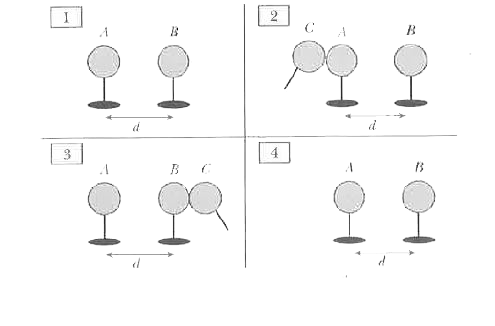
Determine the magnitude of the electrostatic force that sphere A exerts on sphere B in Frame 4. View SolutionQuestion 41
A large negatively charged object was placed on an insulated table. A neutral metallic ball rolled straight toward the object but stopped before touching it. A second neutral metallic ball rolled along the same path as the first ball. Struck the first ball driving it a bit closer to the negatively charged object and stopped. After all stopped rolling, the first ball was closer to the negatively charged object than the second ball. At no time did either ball touch the charged object. which statement is correct concerning the final charge on each ball ?View SolutionQuestion 47
Two small spheres of masses M1and M2 are suspended by weightless insulating threads of lengths L1 and L2. The spheres carry charges Q1 and Q2 respectively. The spheres are suspended such that they are in level with one another and the threads are inclined to the vertical at angles θ1 and θ2respectively . Which one of the following conditions is essential for θ1=θ2 ?View SolutionQuestion 48
Three non-conducting infinite planes of charge A, B, and C are vertical and parallel to one another. There is a uniform electric field →Ep to the right of plane C. The field →Ep points to the left and the field →Ep to the right of plane C. The field →Ep points to the left and the field →Ep points to the right. The signs of the charges on the plates A, B and C may be View SolutionQuestion 49
The given figure shows an equilateral triangle ABC. A positive point charge |q is located at each of the three vertical A, B and C. each side of the triangle is of length a.
A point charge Q (that may be positive or negative) is placed at the mid-point between B and C.
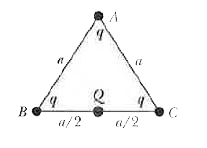
Is it possible to choose the value of Q (that is non-zero) such that the force on Q is zero ? Explain why or why not.View SolutionQuestion 50
The given figure shows an equilateral triangle ABC. A positive point charge |q is located at each of the three vertical A, B and C. each side of the triangle is of length a.
A point charge Q (that may be positive or negative) is placed at the mid-point between B and C.
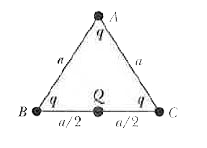
Determine an expression for the magnitude and sign of Q so that the net force on the charge at A is zero newtons.View SolutionQuestion 51
The given figure shows five particles are shot from left into a region that contains a uniform electric field. The numbered lines shows the paths taken by the five particles. A negatively charged particle with a charge -3Q follows path 2 while it moves through this field. Do not consider any effects due to gravity.

In Which direction does the electric field point ?View SolutionQuestion 52
The given figure shows five particles are shot from left into a region that contains a uniform electric field. The numbered lines shows the paths taken by the five particles. A negatively charged particle with a charge -3Q follows path 2 while it moves through this field. Do not consider any effects due to gravity.
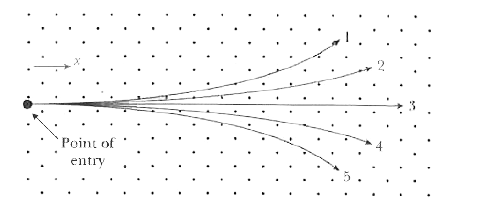
Which path would be followed by a helium atom (an electrically neutral particle) ?View SolutionQuestion 53
The given figure shows five particles are shot from left into a region that contains a uniform electric field. The numbered lines shows the paths taken by the five particles. A negatively charged particle with a charge -3Q follows path 2 while it moves through this field. Do not consider any effects due to gravity.
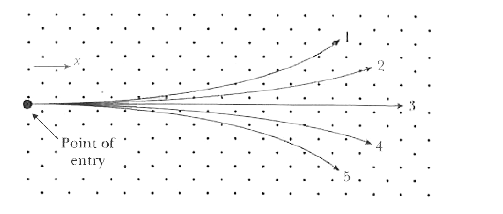
Which path would be followed by a charge + 6Q ?View SolutionQuestion 55
Two points like charges QA and QB are positioned at points a and B (see figure). The electric field strength to the right of charge QB on the line that passes through the two charges varies according to a law that is represented schematically in Figure below accompaanying the problem without employing a definite scale. Assume electric field to be positive if its direct ion coincides with (the positive direction on the x-axis. THe distance between the charges is l.
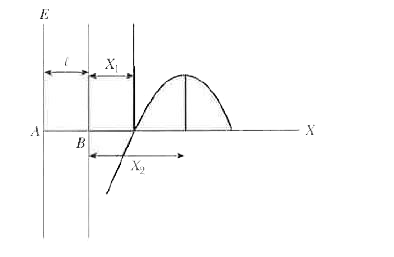
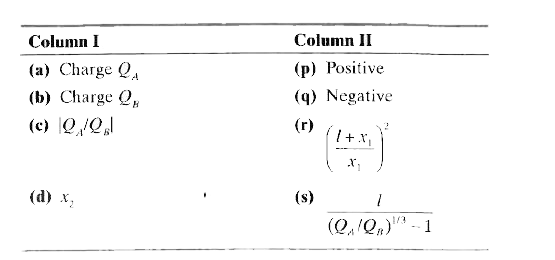 View Solution
View SolutionQuestion 56
An electric dipole is the combination of two equal and opposite charges q and -q, respectively, separated by distance 2a. There are different points where we can find electric field due to the electric dipole. In the given table, column 1 shows different positions of point where we have to find electric field due to dipole, column 2 shows the figure of dipole with different positions of point where we have to find the electric field and column 3 shows the value or final formula of the electric field of different positions of the point.
when point P lies on the equatorial plane of the electric dipole, electric field due to +q is ?

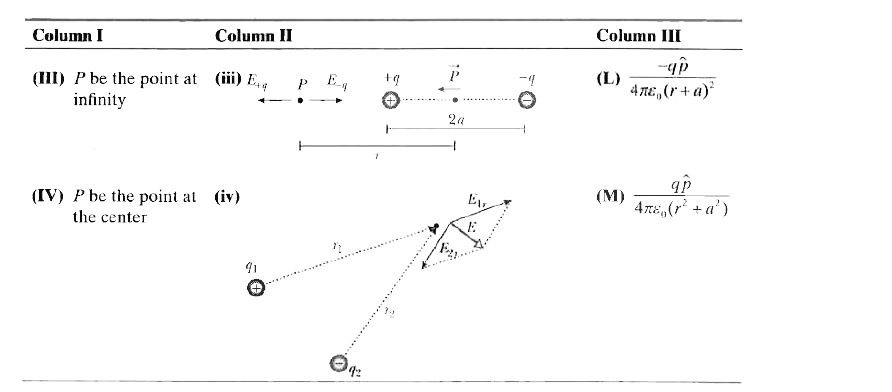 View Solution
View SolutionQuestion 57
An electric dipole is the combination of two equal and opposite charges q and -q, respectively, separated by distance 2a. There are different points where we can find electric field due to the electric dipole. In the given table, column 1 shows different positions of point where we have to find electric field due to dipole, column 2 shows the figure of dipole with different positions of point where we have to find the electric field and column 3 shows the value or final formula of the electric field of different positions of the point.
When point P lies on the axis of the electric dipole, electric field due to -q is ?

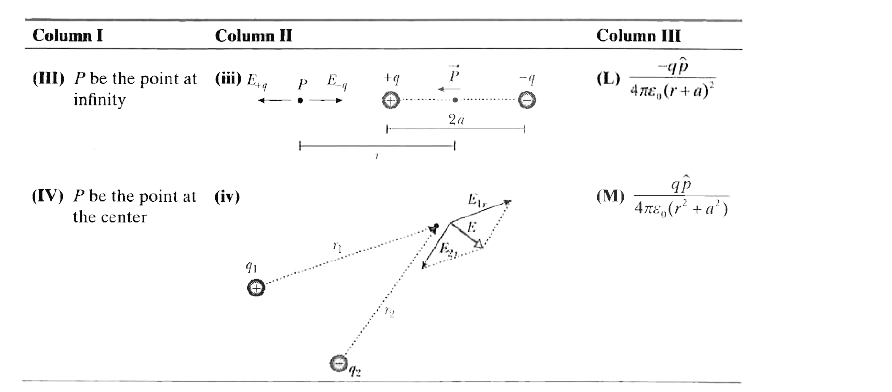 View Solution
View SolutionQuestion 58
An electric dipole is the combination of two equal and opposite charges q and -q, respectively, separated by distance 2a. There are different points where we can find electric field due to the electric dipole. In the given table, column 1 shows different positions of point where we have to find electric field due to dipole, column 2 shows the figure of dipole with different positions of point where we have to find the electric field and column 3 shows the value or final formula of the electric field of different positions of the point.
When point P lies on the equatorial plan of the electric dipole, electric field due to -q is ?
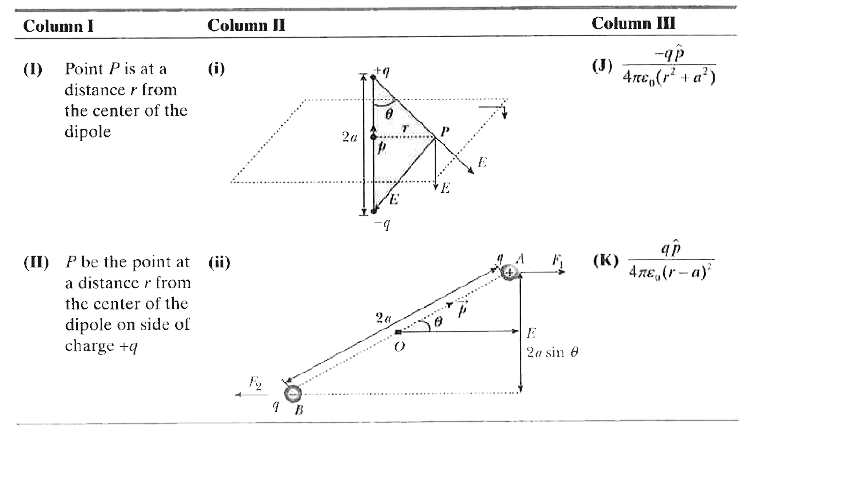
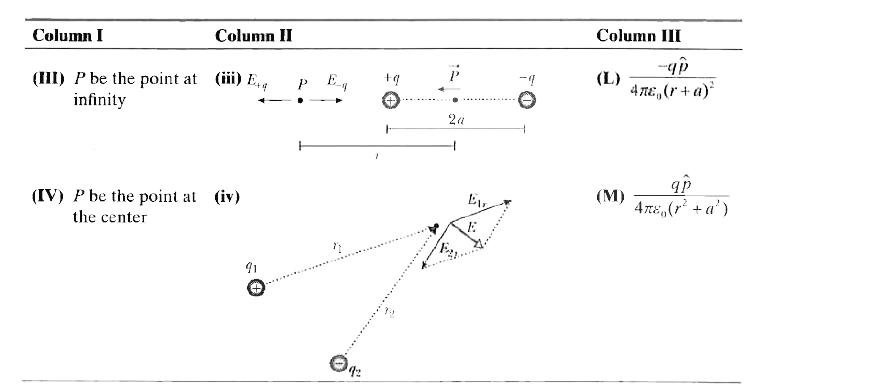 View Solution
View SolutionQuestion 59
Consider the figure given below
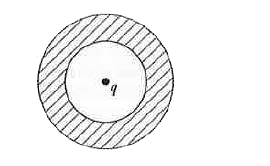
A charge Q is placed inside the Spherical conductor shell. In the given table, column 1 shows different charges, column 2 shows the positions of the electric charge and column 3 shows the different types of charge distribution.

In which case will the charge distribution be non-uniform ?View SolutionQuestion 60
Consider the figure given below
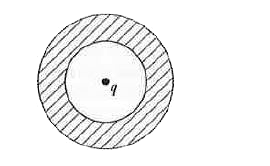
A charge Q is placed inside the Spherical conductor shell. In the given table, column 1 shows different charges, column 2 shows the positions of the electric charge and column 3 shows the different types of charge distribution.
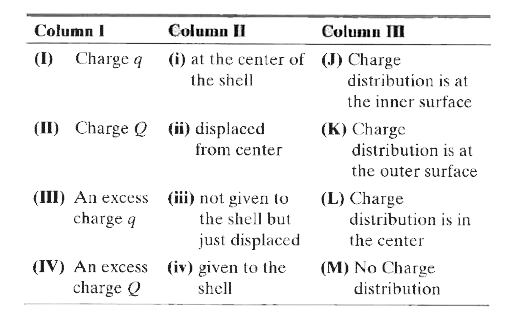
In which case will the Charge distribution be uniform ?View SolutionQuestion 61
Consider the figure given below
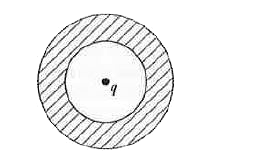
A charge Q is placed inside the Spherical conductor shell. In the given table, column 1 shows different charges, column 2 shows the positions of the electric charge and column 3 shows the different types of charge distribution.
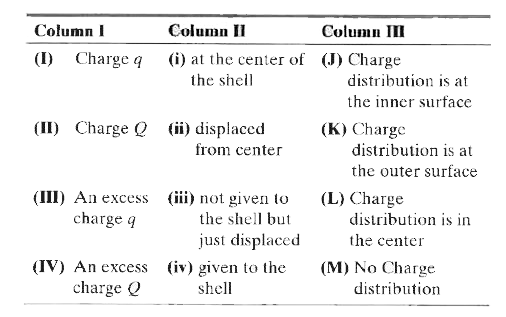
What heppens when the charge is near the conductor shell ?View SolutionQuestion 63
Two spherical objects are separated by a distance of 1.80×10−3m. The objects are initially electrically neutral and are very small compared to the distance between them. Each object acquires the same negative charge due to the addition of electrons. As a result, each object experiences an electrostatic force that has a magnitude of 4.55×10−21N. How many electrons did it take to produce the charge on one of the objects ?View Solution

